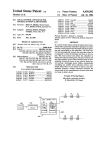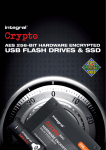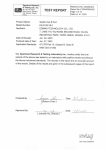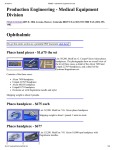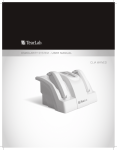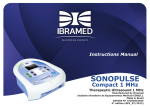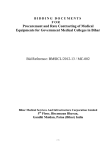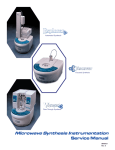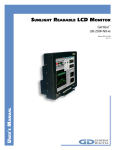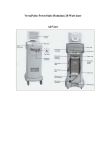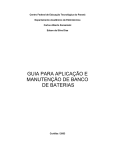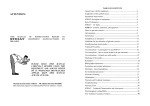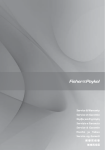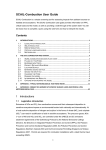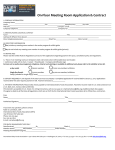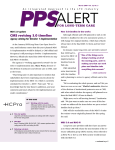Download Minimum standard guidelines of care on requirements for setting up
Transcript
This downloaded PDF Article is supported by LUMENIS the makers of World’s renowned LightSheer and Ultrapulse Laser Recommendations Minimum standard guidelines of care on requirements for setting up a laser room Niteen Dhepe Member, Dermatosurgery taskforce, IADVL, SkinCity, Post Graduate Institute of Dermatology and Lasers, Solapur, Maharashtra, India. Address for correspondence: Dr. Niteen V. Dhepe, SkinCity, Post Graduate Institute of Dermatology and Lasers, Employment Chowk, Solapur, Maharashtra, India. E-mail: niteendhepe@yahoo. com ABSTRACT Introduction, definition, rationale and scope: Lasers are now becoming an integral part of dermatological practice in India, with more and more dermatologists starting laser dermatology practice. Lasers, when are used with care, by properly trained operators, in carefully designed environment, can deliver a range of useful aesthetic and dermatologic treatments. Facility: Laser treatment is an ofÞce procedure, hence it does not require hospital set-up. The laser room facility requires careful planning keeping in mind safety of both patient and operator, convenience of operating, and optimum handling of costly equipments. The facility should be designed to handle procedures under local anesthesia and sedation. Facilities, staff and equipment to handle any emergencies should be available. Location: A room in existing dermatology clinic can be adequately converted to a laser room. Dimensions of laser room, its door and patient’s table should be such that it should facilitate easy movement of patient, machine trolley, operator and assistant in case of routine procedures and in emergency. Physician Qualification: Any dermatologist with MD or diploma in dermatology can do laser procedures, provided he/ she has acquired necessary skills by virtue of training, observing a competent dermatologist. Such training may be obtained during post graduation or later in speciÞed workshops or courses under a competent dermatologist or at centre which routinely performs such procedures. Electricity and uninterrupted power supply: Laser equipments should be connected to stabilizer or UPS circuits only. Preferably an on line UPS as recommended by the laser company should be installed. Earthing of the equipment is essential to avoid damage to the equipment and electrical shocks to the operator. SufÞcient power back up to complete the procedure if power is off midway, is essential. Air-conditioning: Laser machines should be operated in low ambient temperature, with low humidity and dust free environment for longer life of machines. Patient chair: A dental/cosmetic chair with adjustable task light is a suitable option for patient positioning. The chair should have the option to tilt head down or ‘syncope position’ to facilitate resuscitation of a patient in vasovagal shock. Maintenance: Annual maintenance contract (AMC) is essential after warranty period is over and is essential for insurance purposes. Mobile Laser Unit: Mobile laser units are of relevance in the Indian context to render laser facility available in smaller towns. A laser with Þber optic delivery system can be made mobile after consultation with supplier. However a laser with an articulated arm delivery cannot be made mobile. Proper packing with shock absorbing material is necessary during transportation. The area where lasers are to be moved to and operated should have appropriate facilities as mentioned above. IADVL Taskforce 2008-09 consisted of the following members: Dr. Venkataram Mysore (coordinator), Dr. SC Rajendran, Dr. Sharad Mutalik, Dr. Niteen Dhepe Dr. Sujay Khandpur, Dr. Sanjeev Aurangabadkar. Ex ofÞcio members: Dr. S. Sachidanand, President IADVL Dr. VK Sharma, President elect IADVL, Dr. Chetan Oberai, Past president, IADVL, Dr. Rajeev Sharma, Secretary IADVL LEVEL OF EVIDENCE Level A: Strong research-based evidence; multiple relevant, high-quality scientiÞc studies with homogeneous results. Level B: Moderate research-based evidence; at least one relevant, high-quality study or multiple adequate studies. Level C: Limited research-based evidence; at least one adequate scientiÞc study. Level D: No research-based evidence; expert panel evaluation of other information. For disclosures and disclaimers, please refer to the table of contents of this supplement How to cite this article: Dhepe N. Minimum standard guidelines of care on requirements for setting up a laser room. Indian J Dermatol Venereol Leprol 2009;75(Suppl 2):101-10. Received: September, 2008. Accepted: October, 2008. Source of Support: Nil. Conflict of Interest: None declared. Indian J Dermatol Venereol Leprol | July-August 2009 | Vol 75 | Suppl 2 S101 This downloaded PDF Article is supported by LUMENIS the makers of World’s renowned LightSheer and Ultrapulse Laser Dhepe Laser room guidelines Records: Patient’s health declaration questionnaires, laser register are essential records. Digital photography before and at regular intervals after procedure is an essential record. Detailed informed consent in patients language for each procedure explaining nature of procedure, anesthesia used, and machine used, post operative down time should be signed by patient. Drugs, anesthesia and sterilization: An electrocautery machine to control bleeding, equipments for airway maintenance, other instruments for emergency resuscitation and an emergency drug tray are essential. Standard sterilization practices are adopted. For most of laser procedures topical anesthesia is sufÞcient. Safe laser use: Protocols of safe laser use to avoid burns or eye damage to patients or operator are adopted. Reßective surfaces like mirrors, reßective jewelleries are not allowed in laser room. Machine should always be on standby mode when not in direct use. It should be used by authorized operator only. Eye protection: Goggles of sufÞcient optical density (OD) intended to protect from speciÞc laser wavelength are to be used by all persons in laser room. Patient is given either same goggle or laser opaque shield. For procedures around eyes or on eyelids, internal eye shield made of laser opaque material are to be used. Fire extinguisher complying with local authority Þre rules should be available and staff should be trained to use that. Safety and emergency protocols: Protocols for certain situations like vasovagal attack, anaphylaxis, uncontrolled bleeding, Þre, accidental eye exposure should be in place and staff should be trained for these situations. Key words: Guidelines, Laser, Procedure room INTRODUCTION Lasers are now becoming an integral part of dermatological practice in India. Many dermatologists starting new dermatology practice seek to include lasers in their practice. Definition, Rationale and scope • Lasers, when used with care by properly trained operators in carefully designed environment, can deliver a range of useful cosmetic treatments. This calls for establishing minimum standards at the national level with the main focus on patient safety and hence the scope of guidelines. These guidelines are of general nature and may need to be interpreted and adopted in the context of individual situations. These guidelines are based on the available evidence in this rapidly evolving field and may need changes as per future research and publications. • These guidelines do not supersede any local, state or central government laws. Facility • Laser treatment is an office procedure, hence it does not require hospital set-up. However surgical laser procedures can be done in dermato-surgical minor theater. A procedure room in dermatologists’ clinic can very well be converted into a laser room.[1, 2] • Laser procedures are classified as surgical and S102 nonsurgical laser procedures. • Laser procedures which cause minimal or no surface injury are performed under local anesthesia or without any anesthesia. • Surgical laser procedures requiring extensive nerve block or general anesthesia, with anticipated bleeding or anticipated larger raw skin surface injury need a dermato-surgical theatre facility. The laser room facility, also called ‘controlled area laser’ requires careful planning keeping in mind safety of both patient and operator and convenience of operating and optimum handling of costly equipments. This includes planning for location, dimension, non reflective and laser opaque surfaces and lighting, electrical requirements and air conditioning, ventilation and smoke evacuation, uninterrupted power supply, operation table or chair, operator’s chair, eye protection devices, pre-laser and post laser kits, surgical instruments, sterilization of devices, asepsis and emergency management system. These are described below in detail. Physician qualification (evidence level B) • Any qualified dermatologist (DVD or MD) may perform the procedure.[3-5] • To ensure successful cosmetic outcome, the physician should have basic knowledge and training about laser physics and laser tissue interaction. • The training may be obtained during postIndian J Dermatol Venereol Leprol | July-August 2009 | Vol 75 | Suppl 2 This downloaded PDF Article is supported by LUMENIS the makers of World’s renowned LightSheer and Ultrapulse Laser Dhepe graduation if the centre for post-graduation offers such training or later in dedicated workshops. Proper hands on training should be obtained from equipment supplier’s medical experts or from a dermatologist/plastic surgeon experienced in performing the procedure. • The physician should be familiar with early recognition, prevention and treatment of post-laser (post procedure) complications such as hyper or hypo pigmentation, scarring, burns etc. Nonphysician operator qualification Many lasers are simple to use and a nurse or a nonphysician operator may be allowed to perform the laser after proper training. These include nonsurgical or non-ablative and semi-ablative lasers. However, the nonphysician operator should perform only under supervision of the treating physician; independent working of non-dermatologist operators is not recommended. It should also be understood that primary legal responsibility of result and complications of treatment performed by operator (though trained) lies with the treating physician only. Laser procedure room (evidence level B) • The room and building design should comply with any existing state and local fire, safety, sanitation and building regulations.[4,6] Location • The room in which the laser is used is called a “Controlled Area”. • It is recommended that only one patient be treated at any given time in the laser room. At no time, more than one patient or procedure at the same time in same room is allowed. • A sign must be fitted to the door of the room with the wording: “CONTROLLED AREA – LASER” • The following notice must be fixed to the laser machine itself: “This device must be used by an Authorized Operator only”. Dimension • Laser room has to accommodate patient chair (length 6 feet and width 2.5 feet), a trolley carrying the laser machine (about 3 feet x 3 feet), a cart carrying cooling device (about 2.5 feet x 2.5 feet), a laser operator and at least one assistant. The ideal dimension should be 12 feet by 12 feet. The room should allow free movement of operator for proper Indian J Dermatol Venereol Leprol | July-August 2009 | Vol 75 | Suppl 2 Laser room guidelines positioning of laser probes. Laser room door • Door should be of 3 feet width for easy movements of laser machines with its trolley. • The door should be made of opaque material. This is to prevent transmission of laser light. • The lock should always have preferential access from inside to have uninterrupted exit in case of emergency. • Laser warning sign to be fixed outside the treatment room Floor and walls, Flooring, Cleansing, disinfection • The flooring should be easily washable, kept clean at all times. • Cleaning of laser room must always be supervised by authorized laser operator and care must be taken to protect laser devices and electrical sockets from water. Avoid washing in laser room • Washing area may be attached to the laser room but should not be located within it. There should be an adequate wash hand basin (hot and cold water) with long wing taps with long handle. And adjacent soap and paper towel dispenser. Mains drainage must be in place. • Reflective surfaces should be avoided (walls, ceilings and worktops etc). Electrification and uninterrupted power supply: Level of Evidence- Level-B • A three phase electric connection is preferable if multiple laser and / or cooling devices are used [7] • Higher capacity meter is fed with thicker and stable cables and is preferred. Electrical load is calculated on starting load of the equipment which is usually double the labeled working load. Starting load may be calculated by using ampere-meter (Ammeter) device. Avoid lower capacity meter fed by thin cables which in case of overload or under load may melt and cause damage to equipments. • Each socket board should be secured by proper earthing or grounding. Ungrounded connection decreases machines’ productive life. In addition, it may also be associated with a risk of electric shock to the operator. • Imported machine cables may not be supplied with a grounding pin and this may need to be provided separately. • Three cables from each power plug 15A / 5A should run uninterruptedly to circuit breaker on a control panel. Individual circuiting of plugs protect other S103 This downloaded PDF Article is supported by LUMENIS the makers of World’s renowned LightSheer and Ultrapulse Laser Dhepe Laser room guidelines machines in case of short circuit accident in one plug. • Each wall of laser room should have two panels with two plugs one 5 A and one 15A each. Plug panel should be fitted in each corner one foot off ground and 2 feet away from corner. At least five plug panels to be fitted in a laser room. • It is possible that the same patient may need to be treated with more than one machine in the same session. During such procedures, crossing of equipment probes or cables over the patient is not advised • No extension cords should be used in the laser room as they don’t have grounding most of the time. If at all one needs extension, it must be custom made with grounding and all cable connections tightly fitted. Continuity of grounding cable from machine to underground attachment must be confirmed periodically. A poorly grounded circuit is a silent killer of machine’s capacity. • Always use servo stabilizer for lasers. A laser machine should not be plugged directly on without a stabilizer and / or UPS. • A back-up lighting system must be of sufficient intensity to permit the completion of any procedure under way at the time of general power failure. The back-up system is periodically checked; battery packs (high-intensity flashlights) or back-up generators may be used. • UPS: Uninterrupted power supply online as well as off line is recommended in Indian power supply conditions. UPS should be of 3KVA or more (minimum 2.5 KVA) with 16 batteries of 60 to 100 Ampere capacity each. Voltage KVA determines what load UPS can take and battery capacity determines length of power support when mains are off. • UPS and batteries should be installed in cool and ventilated space. High ambient temperature deteriorates battery life and quality of UPS support. In laser room, points fed by UPS and those fed by stabilizer only or directly from mains should be labeled separately. Plugging high voltage devices like Zimmer, cryo cooling device, devices with compressor accidentally to UPS points may trip UPS affecting function of laser machine already on UPS. Air-conditioning • Most laser machines require ambience temperature 18-220C for normal functioning and hence the need for air-conditioning the laser room. • Dust free and cool environment with well grounded and uninterrupted power supply are necessary for machines’ working life. • Air conditioner (AC) requires 3 phase electric meter connection. Phase feeding AC and laser equipment should be separate so that turning on and off AC will not cause fluctuation in input of laser. • The phase which has less power cut in load shedding period (reliable phase) may be connected to laser circuit and other unreliable phase to be spared for AC. Windows and ventilation • All outside air openings to the surgical area are secured against the entrance of insects or other animals. • Windows are screened or closed. Laser Room - Shelf planning A cupboard with non reflective surface to store equipments and consumables is essential. S104 Treatment chair, operator chair, light and illumination: Evidence level: Level C • It is preferable to have a treatment chair with movable sections. Recommended dimensions include 6 feet length, 22-24 inches breadth, to allow the patient to be positioned properly so the operating team can maintain the airway, quickly alter position of the patient in an emergency, and provide a firm platform for the management of cardiopulmonary resuscitation.[8] • A dental chair/cosmetic chair/ophthalmic chair with manual or electric manipulation may all be used. Facility of ‘syncope position’ is preferable in the treatment chair as it helps immediate resuscitation in case of vaso-vagal attack. • A foldable cosmetic chair used in beauty - parlors can be a cheaper option for most of laser procedures except for certain procedures on neck. • An adjustable task light, either fitted on the dental/ cosmetic chair or situated separately is preferred. Four 40-watt fluorescent tube lights can be a good alternative fitted preferably in roof or on wall near treatment end. Switches for each tube should be separate so that the required level of illumination can be selected. A headlight may be used for fine procedures • The surgeon’s chairs should have adequate back and foot support and should be movable with wheels. • Waste bin – metallic/washable with lid and polythene disposable bag inside should be preferred. Provision for wall cabinets to house consumables and Indian J Dermatol Venereol Leprol | July-August 2009 | Vol 75 | Suppl 2 This downloaded PDF Article is supported by LUMENIS the makers of World’s renowned LightSheer and Ultrapulse Laser Dhepe instruments can be made to clear the floor space. The depth of the cabinets could be around 1 foot. Treatment kits Plastic trays with all consumable and preparation material should be kept ready in a tray. In a busy treatment centre, with many procedures being performed daily, 4 to 6 such trays for each procedure may be kept ready so that it saves time of preparation before starting procedure. A sample treatment kit for Laser hair removal may include: Razor, hypo-allergic (micro-pore) tape, marking pen, antiseptic soothing ointment, frozen ice packs, patient external eye shield, a printed post treatment instruction sheet, EMLA cream tube etc. Equipments: Level of Evidence- Level-B • Maintenance: Three important pre-requisites for longer life of laser machines are: dust free environment, low ambient temperature and well grounded and uninterrupted power supply without voltage fluctuation.[9,10] • Machines must be covered during cleaning of laser room and when not in use. • Regular service visits of service engineer should be scheduled as per manufacturer’s recommendation. • The Annual Maintenance contract (AMC) from supplier is essential after warranty period is over. • AMC is also essential for insurance. • Insurance: Fire insurance is a minimum for all costly devices. • Breakdown insurance is costly, (it has a very high premium) hence to be done in very delicate machines and as per usage of machine. Machines if handled by multiple operators or operated in multiple rooms should always be insured. • In mobile laser units, Insurance for mobility from one clinic to another or one city to another should be specifically obtained, though this has high premium. • While taking insurance it is essential that it is clearly specified which parts are covered for e.g. fiber optics, laser modules etc. It is important that these terms are included in the cover note and the final policy. • Cooling devices: Cooling is a mainstay in patient safety and getting better results. External cooling devices like Zimmer contains compressor hence Indian J Dermatol Venereol Leprol | July-August 2009 | Vol 75 | Suppl 2 Laser room guidelines they require separate electric circuit. • Provision should be made for ice cubes or ice packs. • Cooling gel packs are better alternative to ice cooling • Measuring devices: measuring tape, measuring scale, vernier caliper, various moulds for measurement of venous diameter, infra red thermometer are some of the pre-treatment measuring devices which help to document results objectively. Mobile laser unit: Level of Evidence- Level-D In India, laser machine is often shared between different clinics. So machine needs to be shifted from one clinic to other clinic and one city to other city. In the economics of the Indian situation, this is both essential and also unavoidable. The taskforce therefore recommends that mobile laser units are acceptable. However the following guidelines are recommended for establishing a mobile laser unit. • Lasers with articulated arm delivery system (whose output is reflected through series of fitted mirrors) are not recommended to move from the place of installation. • However, most of the newer laser devices come with fiber-optic delivery system and can therefore be made mobile. • Option of making laser mobile should be thoroughly discussed with supplier and an assurance of support for mobility in writing is obtained if machine is in the warranty period. • Annual maintenance contract (AMC), done after warranty period is over, should include clause of mobility support. • Insurance: Usual and routine insurance policies do not cover risk of mobility. A special tailor made insurance policy subject to the locations of transport and modes of transport may be designed after discussion with the insurance companies, though this may attract a higher premium rate (also called special contingency insurance.) • Machine should be transported in original manufacturer’s packing case designed for shipping. • If a special case is to be designed, PU (polyurethane) foam instead of regular PE (polyethylene) foam with adequate thickness at bottom (min 6 inches) is recommended. • Authorized laser operator should always accompany the machine all the time. S105 This downloaded PDF Article is supported by LUMENIS the makers of World’s renowned LightSheer and Ultrapulse Laser Dhepe Laser room guidelines • Servo stabilizer and / or UPS should be available at other facility where mobile laser is to be used. The other clinic also should have class 1 facility. • Local Regulation: Octroi and entry tax is prevalent in municipal corporation areas in some states. Copies of octroi payment at original location and prior permission of transport from both the municipal corporations is to be obtained every time. Cleaning of laser and other devices • Laser machine is to be cleaned periodically as per the instruction in its user manual by authorized operator only. No other staff should touch the machine for cleaning purpose. • No water is to be used near machine • Outer surface of device is to be cleaned with spirit swab or acetone swab. • Cables of machines to be checked for snug fitting after cleaning. • Laser tips touching patients’ skin should be cleaned before using for other patient. • IPL (Intense Pulse Light) tips to be cleaned of gel with spirit swab. Covers of IPL filters to be cleaned off gel. Unclean IPL glass filters can catch fungus and turn opaque blocking output. Sterilization: Level of Evidence- Level-A • Adequate procedures that ensure appropriate sterilization or disinfection of instruments and equipment should be in place.[11-15] • Steam, dry heat, or gas sterilization is recommended for critical instruments. Instruments and surgical sets are stored in dry, sterile, dated packs. Minimum emergency equipments[16-19]: A blood pressure measuring device should be available. Traditional sphygmomanometer plus stethoscope, or automatic system; additional cuffs for large Table 1: Emergency medications The following drugs need to be maintained: DRUGS (Quantity) Xylocaine without adrenaline (5) Xylocaine with adrenaline (5) Adrenaline- 1.1000 (5) Atropine- 0.6 mg (5) Sodium bicarbonate ampoules (2) Chlorpheniramine maleate 22.75 mg/ml, 2cc (2) Hydrocortisone 100 mg/ml (2) EMLA (Eutectic Mixture of Local Anesthetics) (10) S106 and pediatric patients are available. Emergency medications [Table 1] like hydrocortisone acetate, chlorpheniramine maleate, adrenaline, and atropine should be kept along with the emergency equipments. • An electrosurgical device or other means of hemostasis should be available when ablative treatments are planned. An electrocautery or radiofrequency cautery is enough. • A source of airway maintenance should be available. Mouth-to-mask resuscitation device; or ambu-bag and mask; or a source of oxygen delivery up to 5 L/min should be available. • Local anesthetic agents, with and without epinephrine, should be available. • Anesthesia: The infiltration anesthesia is always administered by the physician. Topical anesthesia may be administered by a nurse/non-physician laser operator.[18] • Lignocaine sensitivity test and its documentation is always advisable. Further details are available in IADVL guidelines for local anesthesia • Topical Anaesthesia: Most of the laser procedures are done under topical anaesthesia. Cleaning, disinfection and photography of treatment area is done prior to applying topical anaesthesia. Fifty to 80 minutes is the time gap between application and start of procedure. Thick layer and occlusion under self adhesive plaster is recommended for deeper penetration. Records • Case paper: A clinical history is noted in the patient's record to identify significant medical problems, allergies, bleeding disorders, and current medications. • Recording of data in computers is preferred if feasible. Use of specialized dermatological software is a futuristic trend but remains optional at this time. • Laser treatment register: recording of parameters and relevant findings on a tabular form for subsequent visits. A common procedure register used for other dermatosurgical procedure can be used, if enough space or columns to record laser specific parameters is provided. • A consent form with a questionnaire is covered in a patient’s information sheet filled by the patient or a family member. Any contraindications or sensitivity should be brought to notice of treating dermatologist. • A separate day book with records of the date – Indian J Dermatol Venereol Leprol | July-August 2009 | Vol 75 | Suppl 2 This downloaded PDF Article is supported by LUMENIS the makers of World’s renowned LightSheer and Ultrapulse Laser Dhepe name of patient, diagnosis, treatment given and charges may be maintained. It may be useful for income tax audits. Consent The consent form should have: • The Name of the institute where the therapy would be carried out. • The patient name and treating dermatologist name should be mentioned. • Diagnosis of the condition • Treatment options available and justification of the chosen intervention • The type of anesthesia being used. • Post-operative care required. • Possible complications of the surgery and remedies for the same. • Consent for photo in the same form. A model consent form is attached in annexure. Photography • A digital photograph in standardized condition is the most important document of record. • A good quality digital camera with more than 4 megapixel (MP) resolution, both optical and digital zoom and variable ISO is recommended. • A digital SLR is a luxury and can be very useful for very busy laser practices who can afford a full time medical photographer. • The following parameters should be maintained constant: patient position, distance of camera, light illumination, photographer, and background. Laser Practices • The physician and appropriate staff should be familiar with basic CPR and be able to administer it properly. • The staff should be instructed about potential hazards associated with their duties and know how to minimize risks. This includes applicable OSHA regulations (e.g., hepatitis B virus and HIV exposure, bacterial contamination, sharps hazards, and hazardous chemical or drug exposures). • The staff should be trained about the proper disposal of medical waste and other bio-hazardous material. • All applicable central government, state, and local regulations should be followed. Etiquettes • A female staff or attendant should always be present while examining or treating a female patient Indian J Dermatol Venereol Leprol | July-August 2009 | Vol 75 | Suppl 2 Laser room guidelines • Patients’ privacy, modesty and dignity should be respected by all staff at all times. • Patient must be explained in detail, about the diagnosis, anesthesia planned, pain involved, and instrument being used, laser or electro surgery, post operative care including the necessity of dressing, sunscreens or antibiotics, complications expected and their remedy. The next follow-up should be informed prior. If the patient is receiving oral sedation, the necessity of an attendant after surgery should be prior informed. The cost of the therapy should be explained. • Use of mobile telephones in the laser room should be restricted. Safe operation practices and emergency protocols: Evidence Level B • Before administering local anesthetic agentsObtain history of xylocaine hypersensitivity and usage of beta blockers, aspirin, vitamin E or Ginkobiloba or any other anti-platelet drug.[16,19-22] • Never pass electrical cables over the patient. • Avoid using spirit immediately before laser. • Before laser surgery, wear surgical mask. The pore of the mask should be less than 1.0 micron. The mask should be covering the nose and mouth,. Never put the used mask in your apron pocket. • Smoke evacuator is necessary to suck out laser fumes which can contain HPV and other viruses or potent carcinogens and lung irritants. Plumes of viral infection can cause laryngeal papilloma. Surgical plumes have contents similar to other smoke plumes, including carbon monoxide, polyaromatic hydrocarbons and a variety of toxic gases. As such, they can produce upper respiratory irritation, and have in-vitro mutagenic potential. • Smoke evacuator contains a filter to adsorb these particulate matters. • Smoke evacuator should have specific attributessuction unit or pump, filter, hose and inlet nozzle. The capture velocity should be about 100-150 feet per minute at the inlet nozzle. The filter should be high efficiency particulate air filter (HEPA). The inlet nozzle should be held about 2 inches above the operation site. PRINCIPLES FOR NON-PHYSICIAN LASER USE EVIDENCE LEVEL D • Only a fully qualified dermatologist who has trained himself in safe use and operating of laser can appoint a laser operator S107 This downloaded PDF Article is supported by LUMENIS the makers of World’s renowned LightSheer and Ultrapulse Laser Dhepe Laser room guidelines • A properly trained authorized laser operator may carry out nonsurgical and non-ablative laser procedures only under his direct supervision. • The ultimate responsibility of procedure done by operator though trained lies with the treating dermatologist. Hence independent use of laser by non-physician operator is discouraged. the hair line. Staff should be aware of the location of office fire extinguishers.[20] • A fire extinguisher with ISI mark should be available. The dry chemical type is most common for general office use. For surgical areas, consider a non-residue type fire extinguisher such as Halon or carbon dioxide. METHODS OF SAFE WORK EVIDENCE LEVEL B LASER EYE PROTECTION EVIDENCE LEVEL B • Reflective jewellery worn by the operator and the patient should be removed before the treatment is commenced.[22-25] • Other dermatological procedures and activities must not take place in the laser room while the laser is in use. • When the laser is used the number of persons in the room shall be kept to a minimum. • The Operator should be careful to avoid reflections of the beam from reflecting objects close to the beam path and pay particular attention to the possibility of exposure of their own skin to the laser. • Whenever the laser is not under use, it must be switched off and the key withdrawn and placed in safe custody by the Authorized Operator. • Lasers should be checked for proper operation and test fired prior to each procedure. • The laser should be placed in the standby mode whenever it is not being fired, to prevent accidental firing into the field, prevent accidental fires, and preclude accidents that could occur if the laser and other foot pedals are confused and fired during a procedure. • The operator - the person applying the laser to the skin - and no other person should control the laser foot pedal or hand-switch. • The laser foot pedal should be situated separately from other foot pedals such as electro surgery or microscope controls. • If oxygen is to be administered with in laser room, in an emergency, minimum concentration of oxygen, preferably below 40%, should be used to oxygenate the patient with a laser resistant oxygen chamber. • Lasers have been classified by wavelength and output power into four classes from class 1 (no hazard during normal use) to class 4 (severe hazard for eyes and skin). Medical lasers belong to class III b and IV, lasers requiring eye protection. [15, 26-31] • Appropriate protective eyewear is required for all persons within laser procedure room, during laser use. The IPL (though not a laser) will also require appropriate safety glasses to be worn by personnel within the room. (ANSI 136.3.) • The safety glasses must be specific to the wavelength of the laser being used. Protective eyewear should be labeled according to the optical density and wavelengths filtered [Table 2]. Safety glasses for the IPL unit should be the generic IPL safety eyewear or the more specific “light-speed” eyewear. • Viewing laser or IPL operation through a video monitor offers no risk to the viewer in any situation. • Safety glasses or filters cannot offer eye protection against a direct, close range impact through the safety material into the eyes. Laser operator will therefore not point the laser or fiber directly at any person's face. The laser fiber will always be handled as a "loaded gun" and pointed in a safe direction in the event of an accidental firing. Fire precautions • The CO2 laser presents higher risk for ignition of dry and inflammable materials and appropriate precautions should be taken when necessary, such as the use of moistened towels or sponges to drape the perimeter of laser treatment areas, and avoiding or protecting hair lines that might have hair spray or inflammable prep solutions dried in S108 Table 2: Selecting laser safety glass Common lasers used OD goggle for treating physician OD goggle for patients Excimer 7 7 IPL / Leo 320 3 5 IPL / Leo 420 3 5 IPL / Leo 540 3 5 IPL / Leo 570 3 5 IPL / Leo 650 3 5 ST (infrared laser) 3 5 LP1064 Nd: YAG >7 >7 QS Nd Yag >7 >7 Erbium Yag 6 6 Pixel Er Yag 6 6 Light sheer Diode 6 6 Soprano 6 6 Indian J Dermatol Venereol Leprol | July-August 2009 | Vol 75 | Suppl 2 This downloaded PDF Article is supported by LUMENIS the makers of World’s renowned LightSheer and Ultrapulse Laser Dhepe • Eyewear and filters should be without defect. Frames should not be broken and separated from the lenses. Side shields - if optionally used - should be in place, and no scratches should be on the front lenses. The laser operators or safety officer will make periodic inspections for these defects. • A wet gauge should be wrapped on and around eyes when laser is used near eyes. • Goggles should be adequately cleaned between treatments. • Internal eye shield: In the event the laser must be used directly on the eyelid or within the bony orbit of the eye, appropriate laser safety eye -shields will be placed between the lid and eye to provide protection. Internal eyeshields are metallic and laser opaque. Xylocaine drops are essential for anesthesia. Neosporin eye ointment applied before insertion and after removal of the internal eye shields. Suitable size as per age of patient is selected (small, medium and large). Accident Procedure • If an actual or suspected incident of eye exposure to laser happens, an eye examination should be carried out within 24 hours by an ophthalmologist. The same should be recorded. • Staff training: There should be periodic review training of staff with respect to: • Power failure protocol • Fire protocol • Employees know location of fire extinguishers, evacuation procedures and whom to call. • Adequacy of sterilization • Periodic checking of autoclave function. • Availability and currency of medical supplies • Proper functioning of all monitoring equipment • Items are periodically turned on and tested. Dermatosurgical operation theater guidelines: Surgical laser procedures like CO2 laser or Er: YAG laser, full face resurfacing where relatively more raw area is expected, should preferably done in dermatosurgical minor theater. IADVL guidelines on dermatosurgery theatre provide details on this subject and may be referred.[15, 31] REFERENCES 1. 2. Alster TS. Getting started: setting up a laser practice. In: Alster TS, editor. Manual of cutaneous laser techniques. 2nd ed. Philadelphia: Lippincott, Williams and Wilkins; 2000. p. 2-4. Dover JS, Arndt KA, Dinehart SM, Fitzpatrick RE, Gonzalez E. Guidelines of care for laser surgery. J Am Acad Dermatol Indian J Dermatol Venereol Leprol | July-August 2009 | Vol 75 | Suppl 2 Laser room guidelines 3. 4. 5. 6. 7. 8. 9. 10. 11. 12. 13. 14. 15. 16. 17. 18. 19. 20. 21. 22. 23. 24. 25. 26. 27. 1999;41:484-95. Drake LA, Ceilley RI, Cornelison RL, Dinehart SM, Dorner W. Standards of training for Physicians for the use of lasers in Medicine and Surgery, American Society for Laser Medicine and Surgery, Inc. J Am Acad Dermatol 1995;33:265-70. Hayman MR. Accreditation of the Office-Based Surgical Facility. Am Coll Surg Bull 1995; 80:8-11. Alam M. Who is qualified to perform laser surgery and in what setting? Semin Plast Surg 2007; 21:193-200. Lomando K, Faulconer DR. A workable plan for OR quality assurance. AORN J 1982; 35:1291-5. Olson R. Continuous power to the OR and other critical care areas. Dimensions Health Serv 1975; 52:29-30. Beck WC. Lighting the surgical suite. Contemp Surg 1978;12:9-13. Kerr DR. Electrical design and safety in the operating room and intensive care unit. Int Anesthesiol Clin 1981; 19:27-48. Klebanoff G. Operating room design. Am Coll Surg Bull 1979;64:6-10. Bennett RG. Textbook of Fundamentals of Cutaneous Surgery. In: Bennett RG, editor; illustrated, St Louis: CV Mosby; 1988. p. 181-93. Garner JS, Favero MS. Hospital Infections Program Center for Infectious Diseases, Centers for Disease Control and Prevention. Antiseptics, handwashing, and handwashing facilities. Washington, DC: US, 1985. Available from: http:// wonder.cdc.gov/wonder/prevguid/p0000412/p0000412.asp. [accessed on 2008 Aug 31]. Centers for Disease Control. Recommendations for prevention of HIV transmission in health-care settings. Morbidity Mortality Wkly Rep 1987;36:1S-18S. Simmons BP. Guidelines for hospital environmental control. Infect Control 1982;2:131-7. Stegman SJ, Tromovitch TA, Glogau RG. Text book of Basics of dermatologic surgery. Chicago: Year Book medical publishers; 1982. p. 1-22. Yakel ME, Cummins RO, editors. Illustrated Textbook of advanced cardiac life support. 2nd ed. Dallas: American Heart Association; 1994. p. 267. Gilbert DA, Adamson JE. Procedure manuals in office surgery. Clin Plast Surg 1983; 10:269. Holzman RS, Cullen DJ, Eichhorn JH. Guidelines for sedation by nonanesthesiologists during diagnostic and therapeutic procedures. J Clin Anesth 1994; 6:265-76. American Medical Association. Standards and guidelines for cardiopulmonary resuscitation (CPR) and emergency cardiac care (ECC). J Am Med Assn 1986; 255:2905-84. Sebben JE. Fire extinguishing systems and electrosurgery. J Am Med Assn 1987;17:854-5 Sebben JE. Sterile technique and the prevention of wound infection in office surgery. J Dermatol Surg Oncol 1988; 14:1364-71. Sebben JE. Sterilization and care of surgical instruments and supplies. J Am Med Assn 1984; 11:381-92. Standards of Training for Physicians for the Use of Lasers in Medicine and Surgery, American Society for Laser Medicine and Surgery, Inc. 1991. Available from: http://72.14.235.132/ search?q=cache:mWAwjHkKpmsJ:www.lasertraining.org/ Administrative/Library/Laser%2520Policies%2520-%2520Of fice%2520DermatologyAesthetic%2520Sample%2520Policie s%2520Feb06.doc+andhl=enandct=clnkandcd=1andgl=in. [Accessed on 2008 Aug 31]. Sebben JE. Survey of sterile technique used by dermatologic surgeons. J Am Med Assn 1988; 18:1107-13. Sebben JE. Surgical antiseptics. J Am Med Assn 1983; 9:759-65. Chuang LH, Lai CC, Yang KJ, Chen TL, Ku WC. A traumatic macular hole secondary to a high-energy Nd:YAG laser. Ophthalmic Surg Lasers 2001; 32:73. Elias B. Lasers aimed at aircraft cockpits: Background and possible options to address the threat to aviation safety and S109 This downloaded PDF Article is supported by LUMENIS the makers of World’s renowned LightSheer and Ultrapulse Laser Dhepe security. CRS Rep Congress 2005; 1281:1350. Available from: http://www.fas.org/sgp/crs/RS22033.pdf. [Accessed on 2009 Aug 28]. 28. Breitenbach RA, Swisher PK, Kim MK, Patel BS. The photic sneeze reflex as a risk factor to combat pilots. Mil Med 1993; 158:806. 29. van Norren D, Keunen JE, Vos JJ. The laser pointer: no demonstrated danger to the eyes. Ned Tijdschr Geneeskd 1998; 142:1979-82. Available from: http://translate.google.co.in/tran slate?hl=enandsl=nlandu=http://www.ntvg.nl/node/294932/ Laser room guidelines printandei=Dbu3SZf-KMa-kAXAzNzbCQandsa=Xandoi=tr anslateandresnum=1andct=resultandprev=/search%3Fq%3 Dvan%2BNorren%2BD,%2B.%2BNed%2BTijdschr%2BGene eskd%2B1998%253B142:1979-82.%26hl%3Den%26sa%3DG. [Accessed on 2009 Mar 11]. 30. Mainster MA, Stuck BE, Brown J Jr. Assessment of alleged retinal laser injuries. Arch Ophthalmol 2004;122: 1210-1217 31. Tobin HA, Lee DR, Stewart G, editors. Designing the facility. Ambulatory surgery and office procedures in head and neck surgery. Orlando: Fla, Grune and Stratton; 1986. p. 303-14. Author Help: Reference checking facility The manuscript system (www.journalonweb.com) allows the authors to check and verify the accuracy and style of references. The tool checks the references with PubMed as per a predefined style. Authors are encouraged to use this facility, before submitting articles to the journal. • The style as well as bibliographic elements should be 100% accurate, to help get the references verified from the system. Even a single spelling error or addition of issue number/month of publication will lead to an error when verifying the reference. • Example of a correct style Sheahan P, O’leary G, Lee G, Fitzgibbon J. Cystic cervical metastases: Incidence and diagnosis using fine needle aspiration biopsy. Otolaryngol Head Neck Surg 2002;127:294-8. • Only the references from journals indexed in PubMed will be checked. • Enter each reference in new line, without a serial number. • Add up to a maximum of 15 references at a time. • If the reference is correct for its bibliographic elements and punctuations, it will be shown as CORRECT and a link to the correct article in PubMed will be given. • If any of the bibliographic elements are missing, incorrect or extra (such as issue number), it will be shown as INCORRECT and link to possible articles in PubMed will be given. S110 Indian J Dermatol Venereol Leprol | July-August 2009 | Vol 75 | Suppl 2 Be on the top with Be Lumenis Only company with direct presence in India Best in class Lasers: LightSheer and Ultrapulse Strong Service Network in India Comprehensive clinical trainings from renowned clinicians Strong Base of Users in India For more information please contact : Lumenis India Pvt. Ltd., 308-309-310, 3rd Floor, Suncity Business Tower, Golf Course Road, Sector -54, Gurgaon - 122 002 Haryana, India. Tel: +91-1244854902; M: +91-8800411599, Fax: +91-1244854932 Email: [email protected] India Service Helpline: 0124-4210795, Email: [email protected]











